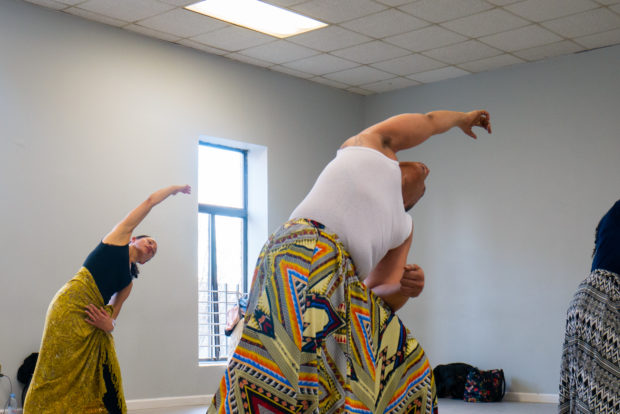Honoring Babalú-Ayé and Oshun
Esohe Osabuohien | eco2132@columbia.edu

Spiritual incantations dedicated to Yoruba gods fill the room as 16 adults, 15 women and one man, file into the second-floor studio of the Cumbe Center for African and Diaspora Dance located on Fulton street in Brooklyn. Today’s incantations are dedicated to the Orisha Elegua — deity of the crossroads, destiny and fate. The dance instructor, Tony “Yemaya” Domenech, shouts over the clamor to let everyone know that they should find a place on the floor and start stretching. There is no time to waste for today’s lesson as the students would be learning the movements for two Orishas, Babalú-Ayé and Oshun.
In the Yoruba tradition, Elegua serves as the gatekeeper between the physical world and the spiritual. Having the students warm up to his incantation creates an open pathway of communication with the other Orishas. Additionally, Domenech, the instructor, carries the title of Yemaya signifying that he is a son of the Yoruba deity, Yemaya, goddess of salt water, mother of all living things, and guardian of mother and children.
Once the students have found their space on the floor, Domenech introduces himself and informs the students that he prefers a high energy classroom and that his methods function on call and response. The students shout a collective, “yes!” and the lesson begins.
Domenech starts the class by explaining the basic steps for all Orisha dances, “everything is flatfooted, knees bent, and shoulders back moving from the pelvis,” he explains. He goes on to say that feet are the foundation for everything, and a firm, flatfooted stance is important for building the base of the dances. A flatfooted stance is also important because the movements are heavily rooted in a west African dance tradition. The students shout their “yeses” in acknowledgement that they understand.
“No one is going to be mounted, we’re just focusing on the dance,” Domenech said while preparing to teach the first step. To be mounted by an Orisha, in the same way of mounting a horse, is to be possessed and embody the Orisha. He explains that this is an exercise in dance and not in ritual. You don’t have to be a follower of the religion to learn the dance.
One of the benefits of non-practitioners of the Yoruba tradition learning how to perform the movements is that they can participate if invited to a Yoruba event, he adds.
Domenech turns up the music, and praise to Elegua, then Babalú-Ayé, fills the room. The students seem very eager to learn the moves and get them down:
Step 1: Center your body towards the three batá drums. The batá drum is a double-headed percussion instrument, used predominantly for religious ceremonies. There are 23 standard rhythms for the Orishas, and when performed a certain way can summon them.
Step 2: Learning the “V steps,” a move that adds an element of Christianity to the Yoruba practice. The V steps movements are performed in the shape of a cross – step forward (the Father), step backwards (the Son), step to the left and then to the right (for the Holy Spirit). These steps are more aggressive, and done during the performances for Shango, Oshun, and Oba; the feet are planted and meet with each beat of the batá drum. Domenech stresses this to the students, a predominantly female class with one male, as he sees them beginning to mimic his movements.
“It should be playful, but not cute,” said Domenech.
With the first steps down, Domenech pauses the class to tell the students the story of the gods they are dancing for.
Babalú-Ayé, also known as Saint Lazarus in Catholicism, is the “Father, lord of the Earth,” overseeing infectious diseases and health. The story of Babalú-Ayé, as told by Domenech, is that he was a lady’s man who went to see the Orisha, Orunmila, for divination. Orunmila counseled Babalú-Ayé to abstain from women for a while, but Babalú-Ayé disobeyed him after becoming smitten by a new woman. As a result, he was cursed with leprosy and banished from his kingdom.
When performing for Babalú-Ayé, he appears as a “crippled man” who carries a cane. Therefore, his dance moves are deep with hard dips and rolling shoulders. As Domenech finishes the story of Babalú-Ayé, the women in his class try the dance moves, but Domenech has to instruct them to make the steps “uglier.” They should look like they’ve lost everything.
